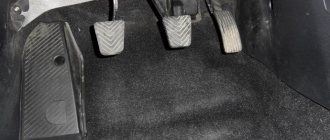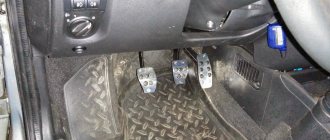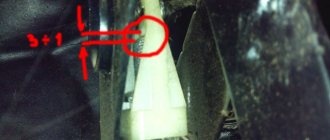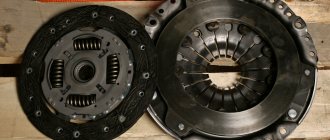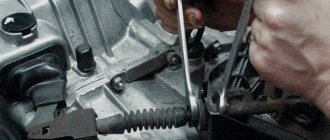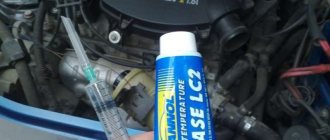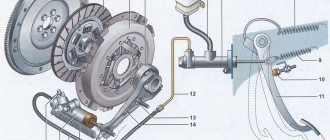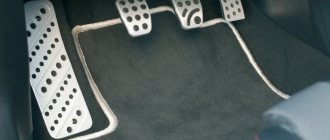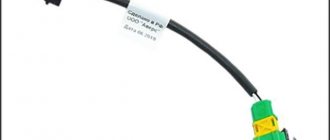Category: KAMAZ
- When to do repair work
- Stages of work First stage - adjusting the pedal
- The second stage is debugging the coupling
- The third stage is adjusting the pusher stroke
KamAZ is a very reliable vehicle that is used in many areas, mainly for cargo transportation. But, like any other equipment, even it can break down from time to time. The clutch system is subjected to especially heavy loads here. If you do not monitor its condition, it may fail. How to adjust the clutch on a KamAZ to improve the performance of the mechanism?
Design features of the clutch
The bulk of KamAZ trucks use a double-disc clutch with a radial arrangement of power springs. To operate the mechanism, a hydraulic drive with a pneumatic amplifier is used. Thanks to this design, the force required to press the clutch pedal is significantly reduced. During the operation of KamAZ, wear occurs on the clutch discs, which must be compensated for by adjustment. Correct adjustment of the mechanism ensures the fuel consumption declared by the factory and confident acceleration of an empty or loaded vehicle.
KamAZ clutch drive mechanism diagram
The main components of the drive, which is shown in the photo, are:
- pedal (1);
- hydraulic unit (2) with reservoir (3);
- highway (6);
- executive pneumatic cylinder (16).
The KamAZ clutch of models 55111, 5320, as well as 43118 and 740 consists of the following structural units:
- clutch housing (A);
- release disc with stamped metal casing (B);
- pressure springs (B) and levers (D);
- one drive disk (E);
- two driven disks (D) with linings (W).
Clutch diagram for KamAZ 740 with diesel engine
The driven discs in the clutch design of a KamAZ truck are made using heat-resistant friction linings, which ensure a long service life of the mechanism. The design of the disks provides a damper for vibrations that occur when the motor shaft rotates. The drive pedal is mounted on special bushings and rarely requires lubrication during operation.
On more modern KamAZ models, single-disc clutches of the so-called Euro type are used. This mechanism is found, for example, on models 6520 or 4308. The supplier of elements for such units is Sachs, and amplifiers made by Wabco are used. There are several clutch models that differ in the amount of transmitted torque. One of the differences between imported amplifiers is the built-in indicator of friction lining wear. Wear is measured by the distance between the amplifier body and the washer on the rod. When the linings are completely worn out, this distance ranges from 23 to 25 mm. In this case, driving a car is still possible, but repair work must be carried out urgently.
Wabco CCGT unit, the wear indicator rod is visible in the upper left part
On some KamAZ models, for example, on 43114, there may be a PGU manufactured by the Volchansky Automotive Unit Plant, in which there is no possibility of adjusting the rod. Typically, such a PGU is either replaced with a customizable one or another rod with adjustability is installed.
How is the adjustment carried out?
If problems occur with the clutch, you should try to make adjustments. When disc slippage occurs (sluggish acceleration, slight burning smell), it is necessary to set the correct clutch stroke.
If the disks are not fully spaced (difficult switching), you will have to perform more operations:
- Set the pedal stroke.
- Remove air from the drive lines.
- Check the liquid level in the PSU.
When using the Euro unit, only the pedal free play needs to be adjusted. Lubrication and adjustment of other clutch parts during operation of the machine is not provided, except for monitoring the height of the fluid level in the drive reservoir.
By adjusting the clutch on KamAZ 5320 and other models we mean setting the correct gap between the release plate plane and the lever heads, as well as adjusting the free play of the pedal and drive clutch. The permissible free play for the clutch pedal must be in the range from 6 to 12 mm.
The gap is understood as the distance between the points of the central part of the pedal platform when the pedal is released and at the moment the master cylinder begins to turn on. The free play is regulated by rotating the eccentric pin located in the connection of the pedal lever with the upper eye of the amplifier rod. The adjustment is made with the pedal tension spring fully depressed, i.e. the pedal should rest against the upper rubber buffer, which serves as a travel limiter.
For example, on KamAZ 65115 the do-it-yourself adjustment process is as follows:
- Unlock the pin castle nut pin.
- By rotating the finger you need to achieve acceptable free play.
- Tighten the nut and secure it with a cotter pin.
- Check the pedal's full travel. If everything is adjusted correctly, it should be between 185 and 195 mm.
On single-disc MFZ units, the adjustment is similar, but the pedal travel should be from 140 to 150 mm.
Below, the process of adjusting the free wheel is demonstrated using the example of KamAZ 4310, the author of the video is Vladimir Krasikov.
Photo gallery
The photographs below show some elements of the clutch drive system of a KamAZ truck.
Conventional double disc clutch
Euro single disc clutch
Classical PSU
Clutch cylinder, the rod for the pedal and the fitting for supplying fluid to the PSU are clearly visible
Clutch debugging
The next stage of adjustment will be to adjust the free play parameters of the clutch, the value of which should be from 3.2 to 4 mm. The measurement is carried out by rotating the adjusting nut.
The sequence of actions in this case:
- Loosen the fork mounting nut.
- Unscrew the fastening pin, allow it to move freely and remove it.
- Rotate the traction fork until the required clearance is obtained.
- Tighten the nut and install the pin in place.
- Install the locking pin.
- Check the setting. When the pedal is fully depressed, the clutch stroke should be at least 25 mm.
Debugging the full stroke of the amplifier pusher
Before starting to debug the mechanism, it is necessary to find out the stroke length of the pusher. To do this, you need to completely disengage the clutch and measure the stroke. If its value is 25 mm or less, then the clutch will not disengage completely. The driver will notice this problem immediately by the difficulty of shifting gears. To find the cause of the problem, you need to check the level of working fluid in the pusher cylinder. The standard volume is 380 cubic meters. see. If the level of the substance is insufficient, it should be topped up.
Hydraulic system diagram
Using the KamAZ 5511 model as an example, adding fluid is done as follows:
- You need to open the reservoir cap located on the drive housing.
- Add liquid to a level 15-20 mm below the edge of the neck.
The second reason for unsatisfactory operation of the amplifier may be air in the system. In this case, the drive system must be bled. This procedure is somewhat more complicated.
On KamAZ 55102 for this you need:
- Add fluid to normal level.
- Remove the protective cap from the bypass valve (installed on the CCGT housing), put on a rubber hose and lower it into a container with liquid.
- Sharply press the clutch pedal all the way.
- Open the valve one turn and press the pedal until the substance stops bubbling at the outlet of the hose. In this case, it is necessary to constantly add new fluid to the supply tank, not allowing it to fall below the 40 mm mark from the top of the tank.
- Close the valve, remove the hose and replace the cap.
- Add fluid to the operating level.
- To control the quality of work, you must press the pedal all the way - the pusher stroke should not be less than 25 mm.
How to install the ignition
To install and connect the ignition switch you will need:
- injection pump;
- metal rod with a diameter of 1 cm and a length of 30 to 40 cm;
- 17mm wrench.
- Set the mark on the high-pressure fuel pump so that the fuel injection system operates 0.4 cm earlier before the piston mechanism reaches the top dead center position. To do this, you need to rotate the engine in the direction of travel until the mark aligns with the arrow mark.
- Using special equipment, fix the piston mechanism as soon as it reaches the top dead center position. To do this, you can use the stopper, which is located on the flywheel housing.
- Bring the mark located on the fuel injection advance clutch to the index arrow.
- Lower the stopper and use the lever to turn the flywheel in different directions.
- When the piston is installed at the compression point, loosen the high pressure fuel pump drive mounting screws and align the mark with the outermost part of the pointer.
Ignition connection:
- connect the red wire to pin 50;
- connect a black wire with black stripes to pin 15;
- attach a pink wire to pin 30;
- connect a brown wire to terminal 30/1;
- connect a black wire to INT;
- connect the battery terminals and check the functionality of the entire system.
Adjusting the KamAZ clutch basket
By adjusting the clutch basket we mean adjusting the tabs placed on the basket. This debugging can be done with the box removed or adjusted directly on the car.
When performing the task without removing the box, you will need a homemade tool, which is a 3.5 mm thick wire with a 20 mm long end bent at a right angle. Using such an improvised feeler gauge, check the gap between the release bearing and the support ring of the clutch feet. The gap is adjusted using a nut on the PSU rod. You can bring the paws to the ring through the hatch in the upper part of the clutch housing. At the same time, it is important to ensure that the paws fit as uniformly as possible to the surface. But it is more correct and reliable to adjust the clutch removed from the engine.
- Place the assembled pressure plate on the template, which will provide a gap of 29 mm.
- Loosen the mounting bolts.
- Set the position of the stop ring for the feet. All four paws should touch the ring at the same time.
- Check the runout of the working surface of the disk.
- Lubricate the front bearing located in the crankshaft.
- Install the clutch using a mandrel, which will ensure alignment of the mechanism discs and the engine shaft.
This adjustment is carried out only with a double-disc clutch. A unit with one disk does not need such adjustment.
The video from the Auto and Moto channel shows the removal of the clutch and clearly shows the design features, as well as the drive for the operation of the mechanism.
Preparing for adjustment
Before properly adjusting and bleeding the clutch on Kamaz 740, 5511 or other trucks, you must perform the following steps:
- Check the tightness of the drive device. To do this, you need to depress the clutch pedal several times. The presence of a serious air leak can be determined by hearing, and a weaker one can be determined by using a soap solution. If brake fluid is leaving the system, this can be determined visually. If problems are detected in the tightness, the components are tightened or the pipes are replaced.
- Carry out diagnostics of the fluid level in the expansion tank of the drive device. The volume of consumables should be about 15-20 mm below the edge of the tank neck. If required, the fluid level is replenished. It is not recommended to mix supplies from different manufacturers when performing this task.
- Check the operation of the pedal release springs, as well as the system release fork pulley lever.
- Tighten the bolts that secure the pneumatic reinforcement device CC. This procedure is performed using a torque wrench. The tightening torque should be about 90-100 Nm.
- Drain condensate, if any, from the pneumatic hydraulic booster.
Adjusting the clutch operation
To complete the task, you will need a special homemade product in the form of a piece of wire, one side of which should be 2 mm and bent at an angle of 90 degrees. The thickness of the rod is at least 3-4 mm. This size is optimal for controlling the gap between the tab outline and the disc release component. Adjustment is made using the nut of the pneumatic booster device. The legs must be brought to the ring through a hole located in the upper part of the crankcase.
You need to adjust the clutch like this:
- The locking screws are unscrewed with a wrench.
- The stoppers and plates are dismantled.
- Each nut is loosened and released 5 turns; for convenience, it is recommended to use a ratchet. If the penny protrudes beyond the surface of the ring, it must be recessed, checking in advance for the presence of ferodo at the bottom.
- When performing this task, you can also change the spring elements if they are worn out. The paws should be positioned so that they are in equal contact with the ring.
- The disk area runout is checked. If necessary, the bearing device is lubricated. The adjustment gap should be about 29-30 mm.
Maintenance
In addition to settings, the clutch of KamAZ vehicles requires regular maintenance, since this significantly increases the service life and reliability of the mechanism on all KamAZ brands.
Using model 53215 as an example, maintenance consists of the following main points:
- Checking the tightness of the amplifier mounting bolts in the clutch drive circuit.
- Monitoring the tightness of hydraulic lines. There should be no oil stains on them.
- General check of serviceability of pedal assembly parts. All elements must be in good condition and not have large gaps in the connections.
- Checking the presence of lubricant in the clutch bearing and fork connection bushing. To supply oil in the clutch housing there are three points equipped with grease nipples. Oil is injected into them using a syringe.
- Draining condensate from the CCGT housing.
- Checking the fluid level in the amplifier reservoir.
When is clutch replacement required?
If all the work performed does not lead to the restoration of the clutch mechanism, then this becomes one of the signals to replace it.
Other signs of critical wear of structural elements are:
- sudden turning on of the disks, resulting in a hard jerk of the car;
- difficulty engaging all gears, accompanied by a characteristic crash;
- sluggish acceleration of the car, while the engine speed clearly does not correspond to the selected gear and speed;
- smell of burning pads when driving.
If such problems occur, it is necessary to stop moving as soon as possible and repair the mechanism. Continued operation of the vehicle with faulty or burnt-out clutch discs will lead to failure of the gearbox.
Video “Adjusting the clutch on KamAZ”
The video, shot for the Auto and Moto channel, demonstrates the adjustment of the clutch installed on a KamAZ 740 diesel engine.
Reliability, excellent performance, efficiency - all this can be said about KAMAZ trucks. The machines are in demand for household, commercial and military purposes. The key to long-term and trouble-free operation is constant checking of the technical condition. Adjusting the KAMAZ clutch is always relevant. This brand is usually equipped with a dry double-disc or single-disc clutch (friction type). During its entire service life, the unit experiences enormous loads. Competent selection of spare parts and timely maintenance will guarantee long-term operation. Adjusting the KAMAZ clutch basket requires experience and certain knowledge.
Setting is necessary when:
- A crackling sound occurs when changing gears.
- Slipping at high speeds.
- Changing the free play of the clutch pedal (it has certain digital values).
If you ignore these signs, expect a serious accident!
We adjust the paws with our own hands
In Kamaz vehicles, the clutch performs the function of ensuring smooth starting of the vehicle, as well as disconnecting the engine from the transmission system when changing gears. The need to adjust the clutch basket feet (hereinafter referred to as the CS) in these car models is a common problem faced by many KamAZ owners.
Paws for KAMAZ clutch basket
The clutch in this car is an important and necessary component of the clutch system. Setting it up is an integral part of technical work, so KamAZ owners will not be able to avoid this activity.
What will you need?
Before we begin the repair work, we should prepare everything that we may need in the process.
- set of wrenches;
- flat slab;
- silicone glue.
KAMAZ clutch adjustment technology
Removing and adjusting the KAMAZ clutch is carried out in several steps.
Adjusting the free travel of the KAMAZ clutch pedal
The pedal must have a play of 6 to 12 mm. Measurements are taken from the central part of the plate. The pedal must be lowered until the main cylinder starts working. If there is a deviation from the norm, adjust the distance between the PSU pusher and the stop at the top.
To do this, you will need an eccentric pin connecting the pedal to the top eye of the pushrod. The pedal for traction must press the clutch pedal against the stop from above. The finger is turned so that the gap between the piston and the PSU pusher is in the range from 6 to 12 millimeters. When finished, tighten the castle nut securely. The full pedal travel should be approximately 19 centimeters.
Adjusting the KAMAZ clutch
The manufacturer recommends maintaining a free play value in the range from 3.2 to 4 millimeters. To measure, you will need to move the fork shaft lever by hand. It must move in the direction from the spherical nut of the pusher. It is located on the pneumatic or hydraulic clutch drive amplifier. Adjusting the KAMAZ clutch clearance will require removing the spring: the lever should move no more than five millimeters. If the free play is less than three millimeters, then it is adjusted using a spherical nut. The idle speed of the clutch must be from 3.2 to 4 millimeters.
Adjusting the KAMAZ clutch drive
To measure the function indicator, it is worth pressing the pedal all the way. If the value is less than 24 mm, then complete shutdown will not occur. It is necessary to measure the free play of the pedal and the volume of fluid in the master cylinder. 380 cubic centimeters is the total volume in the hydraulic drive. If the data does not satisfy the requests, it is important to get rid of air in the system. This will return all indicators to normal.
Adjusting the KAMAZ clutch pressure plate
During this operation, you must strictly follow the sequence:
- Initially, the gearbox is dismantled. You can't do it without helpers.
- Remove the clutch basket.
- The clutch discs are dismantled: first the driven one, then the middle one, and finally the driving one.
- New parts are being installed. The order is already reversed.
- It is important to adjust the nickel of the KAMAZ clutch basket.
- The correct installation of all mechanisms is checked in detail.
- The gearbox returns to its place.
If there is only one disc in the clutch design, the job is much easier!
But even a KAMAZ single-plate clutch, adjusting its parts will require serious skills, strength and knowledge. Don't take risks - entrust the matter to professionals. Or do a one-time replacement with a real mechanic. For some mechanics, adjusting the KAMAZ double-disc clutch without removing the gearbox is a reality.
Work related to clutch replacement
It is recommended to replace the basket if the following shortcomings are found:
- even after adjustment, the car jerks and starts abruptly;
- extraneous sounds in the basket were and are still present;
- the car “thinks” for a long time and does not immediately start moving, despite the fact that the clutch was depressed according to all the rules;
- There is a characteristic burning smell in the cabin - this indicates that the clutch mechanism has simply burned out.
This activity begins with removing the gearbox. This is a very heavy unit that requires several people to work with. After this, you can begin to dismantle the clutch basket.
We see how the clutch discs on KamAZ are arranged - first the driven one, then the middle one, then the driving one. They are all removed. New parts are installed in place of dismantled parts. How to correctly install clutch discs on a KamAZ:
they must be installed in a strict order - initially the first slave comes, then the middle one, and at the final stage the leader;
- since this is a dry type of clutch, there is no need to use any lubricant, this will only worsen the quality of the mechanism;
- instead of traditional discs with friction linings, you can install more modern ones equipped with ceramic elements - they are much more reliable and durable;
- carefully tighten all bolts and nuts. Due to heavy loads, poorly tightened fasteners can become loose over time.
You only need to install clutch discs on a KamAZ yourself if you clearly understand what exactly you are doing. This is a difficult task; if you lack experience or lack the necessary tools, it is strongly recommended to seek help from specialized specialists.
Design and principle of operation
The operation of the mechanism is based on the principle of sliding friction force.
The KamAZ clutch device is used for:
- transfer of rotation from the crankshaft;
- gradual transfer of gears;
- reducing rotational vibrations;
- disconnecting the transmission device from the engine for a short moment.
In a car, gear shift occurs when the clutch pedal is depressed, there is no connection between the engine and the gearbox, and rotation is not transmitted.
The KamAZ leaf clutch consists of the following parts:
- a flywheel that receives rotation from the engine and transfers it to the gearbox through the basket;
- pressure plate complete with springs;
- drive disk assembly with linings and vibration damper;
- plug assembly that breaks the connection;
- an axial shaft to which rotation is applied;
- release bearing;
- spring that reduces vibrations;
- hood;
- structural linings located on the drive disk to reduce friction.
How to adjust the KamAZ clutch
Maintenance is carried out regularly. Increasing the pedal stroke leads to incomplete disconnection of the flywheel and gearbox. This device causes the gears to come into contact, and the load on the teeth of the gears increases. If the accelerator stroke is insufficient, the drive disk does not engage, rotation is not fully transferred, and the machine stops.
Adjusting the clutch on a KamAZ allows you to eliminate faults that are diagnosed based on the following symptoms:
- at the beginning of departure - jerks;
- the friction pedal sticks;
- the accelerator is slow;
- if you check the drive fluid level, a leak is detected;
- extraneous sounds are heard.
The need to adjust the clutch on a KamAZ is checked by measuring the distance from the bottom of the pedal to the floor surface of the driver's seat - the indicator should be 16 cm.
Without removing the box
Adjustment of the clutch operation is carried out by removing the gearbox. But if adjustment is required under road conditions, then the work is performed without removing the structure.
You will need a homemade device in the form of a piece of wire, one side of which is 2 cm long and bent at an angle of 90˚. The thickness of the rod is at least 3-4 mm; this size is convenient for controlling the clearance between the disc release element and the contour of the legs.
The adjustment is made using the pneumatic booster nut. The legs are connected to the ring through a hole at the top of the crankcase. Elements are placed as equally as possible to the area.
The procedure is as follows:
- Unscrew the locking bolts.
- Remove stoppers and plates.
- The nuts are all loosened equally by 5 turns; ratchets are used for convenience.
- If a nickel protrudes beyond the surface of the ring, then it is recessed, first checking for the presence of ferodo underneath.
- The springs can be replaced at the same time.
- The paws are placed so that they touch the ring equally. Then the runout of the disc area is analyzed.
- The front bearing is lubricated. Select an adjustment gap of 29-30 mm.
Setting up the mechanism without removing the gearbox is done in the case of a double-disc clutch; single-disc clutches are not adjusted this way.
How to adjust pedal free play
Check the movement of the coupling by moving the axial shaft lever away from the pusher nut. If the free distance measured at 90˚ is less than 3 mm, then to adjust it, rotate the pusher screw so that the distance of free movement of the coupling is 3.1-4 mm.
The stroke of the amplifier pusher is checked when the accelerator is pressed - the indicator should be more than 2.5 cm. A smaller value does not ensure effective activation. If the pusher stroke of the pneumatic hydraulic booster is less than recommended, then:
- adjust the free play of the clutch pedal;
- control the amount of liquid in the main cylinder container;
- remove the atmosphere from the hydraulic device.
The pedal movement should correspond to the size of 6-15 mm, it is measured in the middle of the pedal. If it is exceeded, the clearance of the piston and pusher is set using an eccentric element connecting the hole at the top of the pusher and the accelerator.
How to adjust the cart
The basket's feet are adjusted on the removed disk or through a gap in the flywheel directly on the machine.
- When the machine is in the pit, remove the box using a winch.
- Inspect the release bearing, springs and collets.
- Unscrew the fastening of the disk to the engine flywheel.
- Remove the pressure mechanism while holding the drive disk.
- Inspect the surface and make adjustments to the paws relative to the area of the disk.
- Check the change in the position of the paws using a plate, taking into account that their round surfaces should touch the template located on the hub.
- After adjusting the clutch basket, the hardware is tightened until it stops. Clutch assembly is done in reverse order.
Installation of clutch discs.
Clutch disc hubs have a protrusion in one direction more than in the other. When installed, their large sides should face in different directions. Toward the flywheel
and towards the clutch basket. The first disk is installed with its larger side towards the flywheel. Next comes the intermediate clutch disc.
The second disc is installed with the larger side of the hub facing the basket. If at least one disk is installed incorrectly. They will bump into each other and the basket will not work.
The intermediate disk must move freely in the grooves of the flywheel. This is a very important condition. There should be no jamming or wedging. Otherwise, it will cling to some kind of disk. At least the disk won't be pressed too hard. But it will constantly rotate. And together with it the input shaft rotates. And you won’t be able to shift into gear without the gear crackling. It is better if the intermediate disk is a little free. A characteristic knocking sound when pressing the clutch pedal is heard on all KamAZ vehicles with two clutch discs. And it does not interfere with the clutch.
It happens that the clutch is adjusted correctly. The basket fully depresses the clutch discs. And when starting off, the transmission engages with a big roar. Or it may not be possible to turn it on at all. That's exactly why. That when the basket is depressed, at least one disk constantly rotates along with the flywheel. When the clutch is released, both discs should stop. Only then will the transmission shift into gear without any problems. And the reason for clutch malfunction is the intermediate disc. It jams in the grooves of the flywheel. Touches the disc. And the input shaft continues to rotate when the clutch is depressed. Therefore, it is very important to pay attention to how the intermediate disk is positioned.
After the cart is installed. It is necessary to correctly adjust the position of the clutch basket feet.
Malfunctions and what to do
Repair of the KamAZ clutch can be delayed if the machine is regularly maintained.
Load, road surface, driving skills affect the intensity of destructive processes:
- wear of the control drive;
- erasing contacting areas;
- change in the tightness of devices.
To identify malfunctions, before adjusting the clutch drive, the automobile clutch is diagnosed:
- Inspect the drive for leaks, determine the degree of destruction of the pedal springs and fork lever.
- Bring the distance of free movement of the cylinder pusher and the fork axle lever to the recommended parameters.
- Lubricate the balls of the release collet and the clutch fork shaft.
- Determine the liquid level in the main cylinder tank and adjust the amount to normal.
- Tighten the bolts of the pneumatic booster device.
- Change the fluid in the hydraulic drive circuit once a year.
Clutch malfunctions are eliminated as the linings of the drive discs wear out.
If it slips
If the mechanism does not turn on completely, the car accelerates slowly or loses power when climbing the highway, or a burnt rubber smell is heard, then there is an explanation for the problems:
- there is no clearance between the bearing pressing on the basket petals and the stop ring;
- oil has leaked between interacting surfaces;
- friction gaskets have become unusable;
- the clamping springs have lost their shock-absorbing qualities or are broken.
